Ah first aid, the often misunderstood and forgotten side of hiking gear. We all somewhat understand the importance of a first aid kit, yet it often falls by the wayside when we are thinking of what to pack for a hike or a backpacking trip.
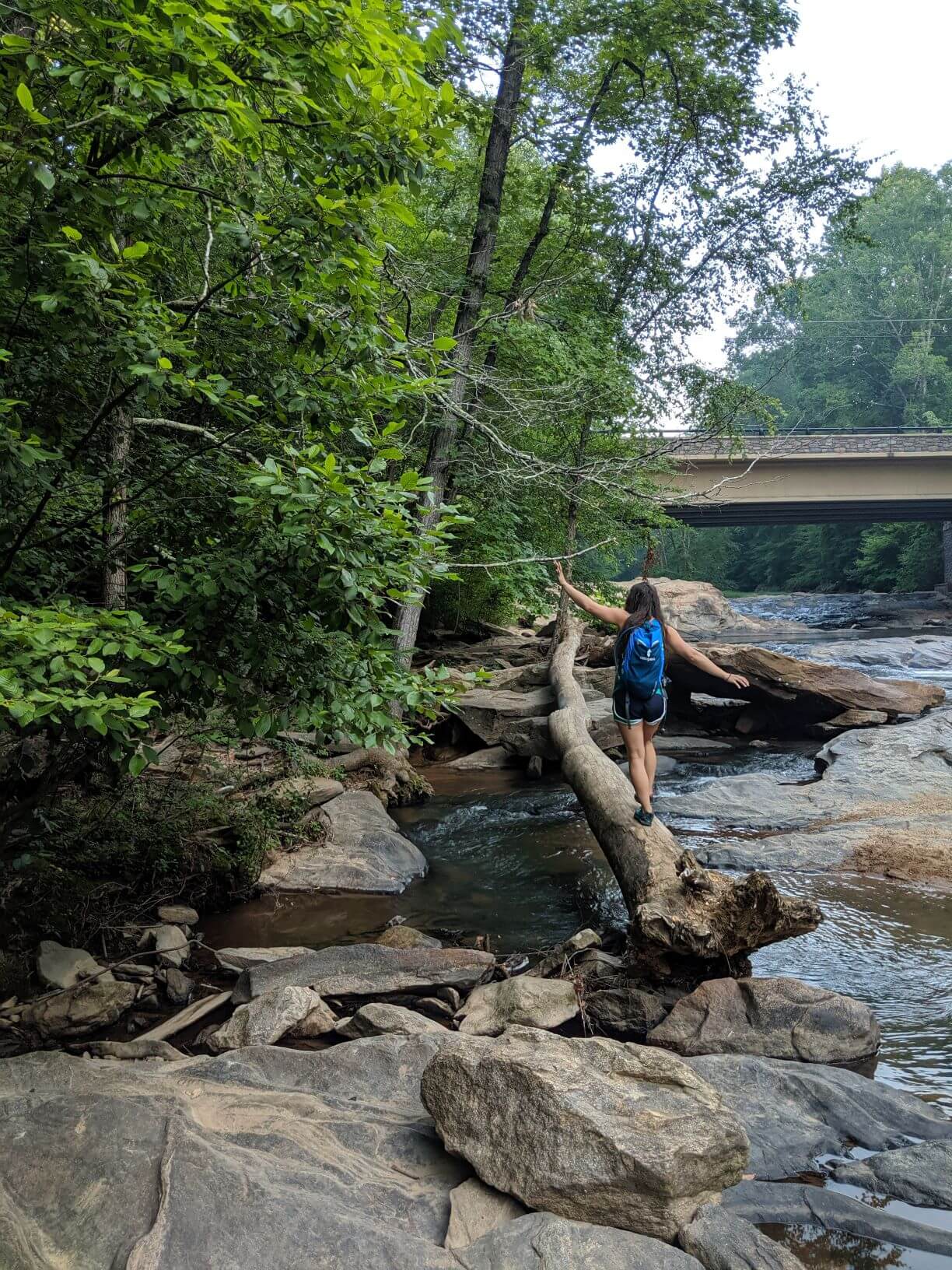
A lot of us know we should be carrying a first aid kit (and a lot of us don’t even know that), but we haven’t gotten around to buying one yet. After all, it’s more extra weight for those backpacking trips where we just want our pack as light as possible. Perhaps one of the reasons you don’t have a hiking first aid kit yet is because you don’t know what to put in it! And that’s why I am here today to talk about the 32 must haves you need for your hiking first aid kit (and then some!)
Hiking First Aid Kit Table of Contents
Let’s get started, shall we?
Why is a first aid kit important?
I think this is pretty obvious because accidents happen in daily life as well, not just on the trail. Some of you may carry a kit in your car, but I think it’s safe to assume we ALL at least have band-aids and neosporin in the house or we live close enough to a pharmacy where we can run and grab something if we need it (or call 911).
When you are out hiking or backpacking, it is a different story. Your phone may not have service, you may be several miles or more from civilization and there are certain dangers that we are not expecting. It is best to be prepared for as much as possible.
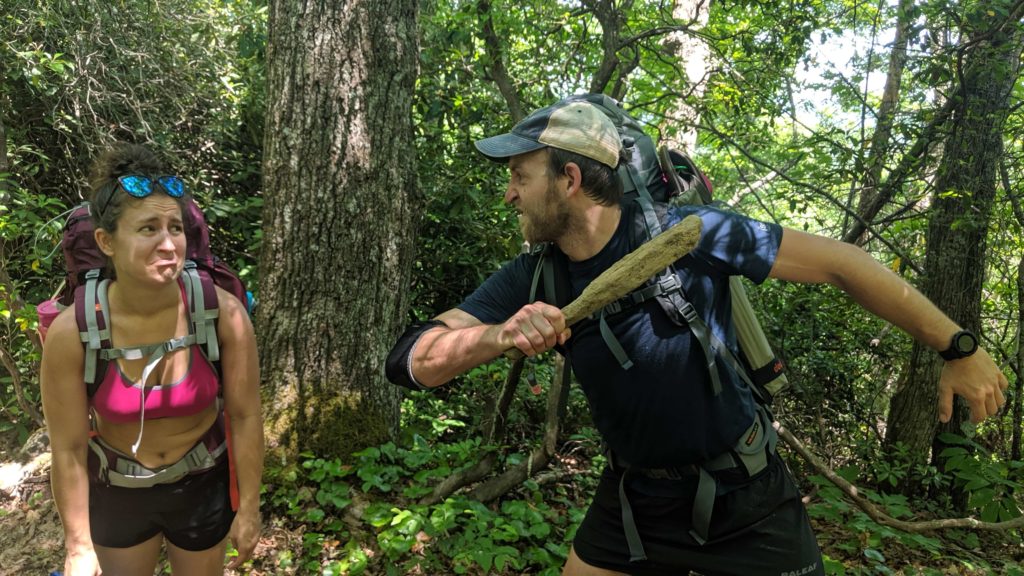
I mean.. You never know when one of your buddies is just going to turn on you. 😉
Now, granted, if you’re going on a mile hike, most wilderness experts will still suggest carrying first aid and I feel a responsibility to inform you well and think I should also promote this idea, however- I’m a firm believer in honesty and I’d be a super hypocrite if I told you to always carry first aid when I, erm… don’t… So maybe this post is for the both of us. 
I 100% agree that it’s always better to have a first aid kit than not, but I think there are certain situations where if something happens and you don’t have a first aid kit on you, you’re going to be just fine. For example, most of the shorter trails around the Atlanta area where I live all have great cell reception, so you can still call 911.
A lot of the trails are really short so you can probably walk back to the car even if you sprain your ankle and like I said, even if you somehow managed to do something like break a leg and you can’t walk out- because you’re on a short trail with great reception near a city, most likely- you’ll be rescued before dark.
However, this does not mean start slacking with not bringing a first aid kit. It’s always better to have. You may never even need it for you, but someone else who isn’t educated and hasn’t read this lovely informative post may get hurt and not have anything and you get to be the hero!
What makes a first aid kit important IS those unexpected situations that are very likely to occur outdoors. You might get stung by a bee and have an allergic reaction. You could cut yourself on a rock or a branch. You could trip and scrape your knee. You could twist your ankle on a rooty trail. You could run into a mountain lion like that one guy who went viral. (Again, depending on where you are hiking, that could be even less likely than being struck by lightning, so this isn’t meant to scare you.)
It’s always better to be prepared. I, for example, run into tendinitis issues A LOT. I swear there are some hikes where I would have been crawling or rolling out (or, with the nice addition of my anxious mind, thinking I’m going to lie there and die) if it wasn’t for my KT-Tape.
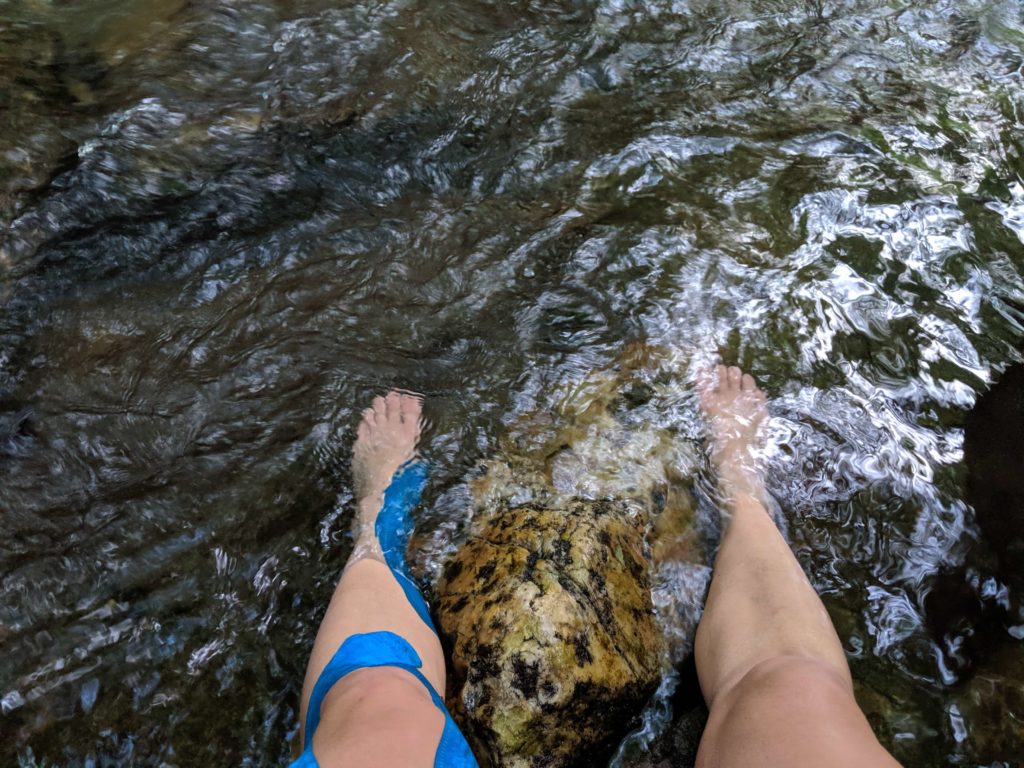
My legs after a 35 mile backpacking trip getting free cryotherapy treatment
A friend of mine got stung by bees when she didn’t know she was allergic and did NOT have benadryl on her. She was fortunately able to make it out, but was losing her ability to breathe and ended up in the hospital vomiting. Unexpected. Almost anything first aid related will be unexpected, which is why we often forget our kits, but this is also WHY it’s extremely important to bring. (Back to top).
What should you have in your hiking first aid kit?
It would be impossible to be prepared for every situation, but there are a few key things you can always carry in your kit, without making your pack too heavy. This list seems long because there are so many items, but you will find most of them are very small and light. If you are just getting started and feel a bit overwhelmed, you could instead purchase a pre-made kit rather than going through this checklist, however in my experience, it is still better to at least supplement a pre-made kit with things that may pertain more to your personal experience.
For example, some questions to consider before going on your adventure:
- How many people are going on the trip? (You only need one first aid kit per group, technically speaking, but a larger group may mean a larger kit!)
- What are the conditions you are hiking in? (For example, will you likely run into poison ivy?)
- Do you have any pre-existing conditions that require medicine? Obviously, you’re going to want to bring that! Diabetics, asthmatics, and those with heart conditions come to my mind.
- This comes with experience, but what struggles does your body run into regularly? (I need my KT-tape for tendon support, for example. Tendinitis strikes me at any moment)
- Do you have any known allergies?
Answering questions like this can direct you to the proper items that you may need to add into your pre-made kit, as these kits usually aren’t tailored to the individual.
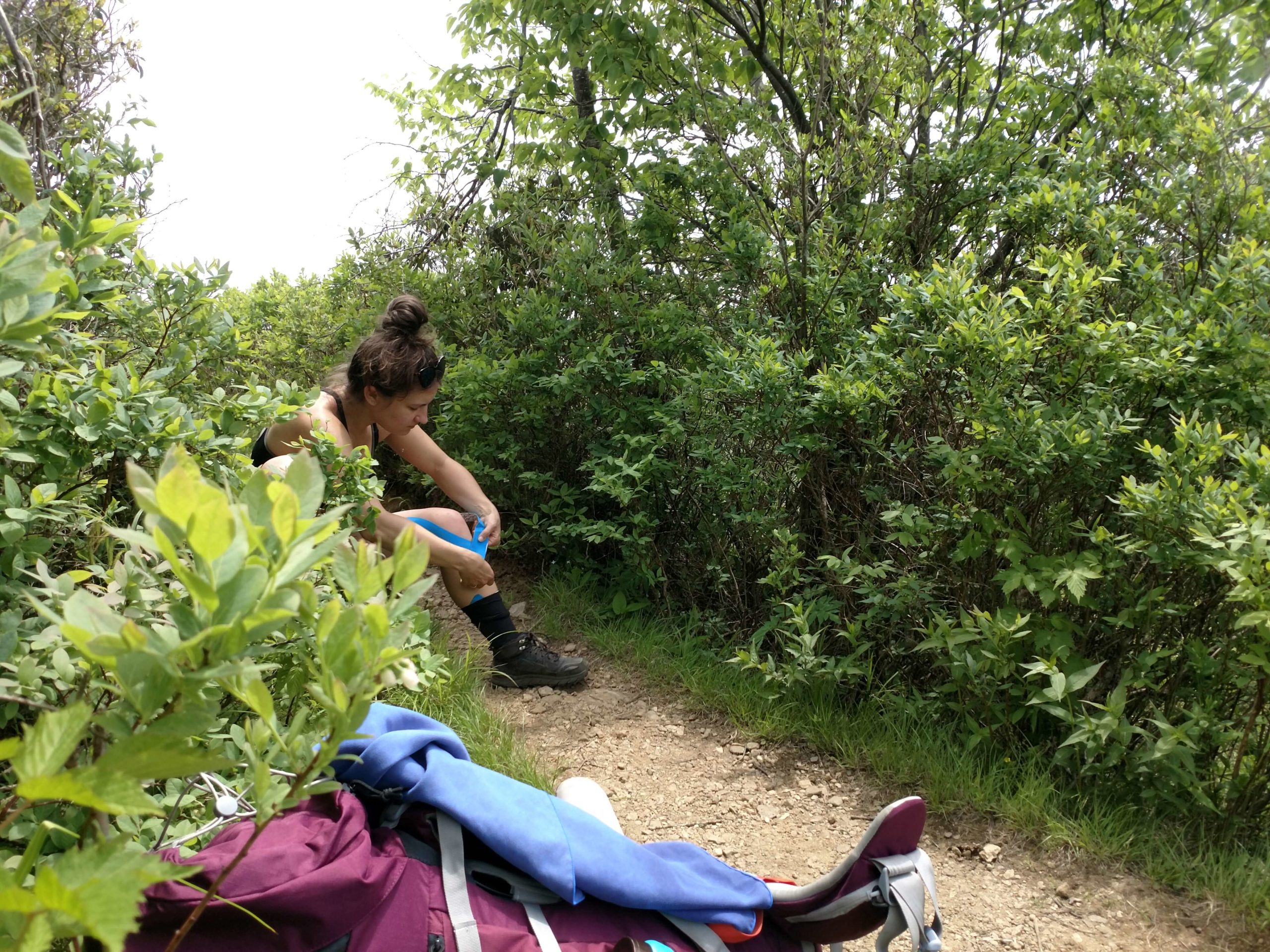
Everyone has different needs for different health problems
If you are ready to make your own kit, however, this is the list of things I have compiled from my research. I have taken a wilderness first aid course, but I have to say when you don’t have opportunities to practice, the info does not stick for me. Therefore, I have poured over resources like NOLS, REI’s checklist, and various other more informed blogs to bring you what I think seems to be the mutually agreed upon IMPORTANT items:
- The first thing I believe you should have in your first aid kit is PREVENTION. Not trying to be a smart ass here (ok, maybe I am), but don’t do dumb shit, especially if you’re unprepared to treat accidents and injuries.
- Watch where you are walking. Look out for things to trip on, stay away from slippery or crumbly cliff edges (or just the edge in general if you aren’t very coordinated), snakes, poison ivy, etc.
- Learn how to navigate situations where you may encounter a wild animal
- Remember to hydrate, eat and pack appropriately (drink enough water and pack what is appropriate to your hike, dress for the weather and wear proper shoes!)
- Go with a buddy (Ok, I go alone often so I can’t MAKE you do this, but if you are inexperienced or terrible at directions, DEFINITELY do not hike alone)
- Educate yourself, sign up for a wilderness first aid course so you know what to expect and how to deal with it
- Be knowledgeable about the place where you are hiking? Is it a wet hike? Buggy? Cold? You could need to pack your first aid kit differently for different situations.
- Warm up & take stretch breaks! This has been one of the contributing factors between me barely making it through an under 10 mile hike and conquering a 23 mile hike.

STRETCH! STRETCH! STRETCH!
- wear you sunscreen and your bug spray where appropriate (you’d sometimes be surprised where you need sunscreen in the mountains! I’ve been burnt on a relatively “cool” day!)
- Moleskin– take care of pesky blisters
- prevention measures: buy appropriate shoes in the first place, break your shoes in before hiking in them, try sock liners, tape “hot spots” before they get worse
- Cloth tape or Athletic Tape – can be used to support sprained ankles or wrapped around gauze to act as a wound dressing
- I personally use KT Tape for support, but this is not for dressing wounds
- Scissors- trauma sheers, to be exact- you don’t want sharp-pointed scissors because it can poke a hole in your backpack AND cut you further if you’re trying to cut clothes open fast!
- Tweezers– NOT beauty tweezers. Splinter removal, tick removal, etc.
- Cross-contamination protection: Hand sanitizer (or soap and water if you have it) and gloves
- Wound Closure Strips– to keep wounds that may require stitches sealed up
- Gauze for days- Rolling gauze and/or Gauze pads (non stick and sterile) and/or blood-stopping gauze (If you absolutely don’t have, clean extra clothing can substitute for gauze)
- Assorted Bandaids- regular assortment & knuckle and fingertip sizes for cuts and small burns (could also use gauze and tape)
- Antibiotic Ointment (a.k.a. Neosporin)– for infection prevention and faster healing
- Benzoine– for better adhesion of bandages (you’re some kind of dirty and sweaty out there, bandages fall off fast!)
- Pain Meds- Ibuprofen (the best, but some have allergies to it), Naproxen (good if you have allergies to Ibuprofen, also good for period cramps), Acetaminophen (best fever reducer), and/or Aspirin (doubles as heart attack prevention for those to who it pertains to)
- Benadryl– great to take for bee stings, snake bites (you need to evacuate if it’s poisonous!) or anything you might have an allergic reaction to
- Anti-diarrheal– diarrhea is a fast track to dehydration if you can’t get off the trail any time soon
- Ace bandage– for wrapping injuries and sprained ankles
- A knife (honestly, this may fall more under the emergency kit category)
- Antiseptic wipes-wound cleaning
- Safety pins– closing bandages, making bandages and slings out of clothes
- Insect bite or poison ivy treatment (benadryl can also help here)
- Triangle bandages– for making slings (can sometimes substitute with clothes)
- Oral thermometer (one site also recommended a hypothermia thermometer)
- Rescue/CPR mask– protects the individual giving CPR from disease/vomit (make sure you have a CPR class before administering this!)
- Irrigation syringe– wound cleaning without having to rub the wound
- 2nd skin or transparent skin dressings-antiseptic and waterproof for keeping bacteria out
- SAM splint– could potentially use trekking poles, clothes, tape, paracord, etc.
- A pocket guide– especially if you have no idea how to treat what you are experiencing
- Notepad & pencil, S.O.A.P. notes– keeping track of symptoms and changes for helping paramedics, making decisions about evacuating or continuing, etc. (something you really need some Wilderness First Aid knowledge for, I recommend a class!)
- Liquid Band-aid– could also use Crazy glue for sealing cuts
- Coban Wrap– if you don’t have it, use the athletic or medical tapes
- Magnifying glass & Small mirror
- Povidone iodine solution– like neosporin, for killing bacteria
- Rehydration salts– reviving dehydration, electrolyte powders are good as well
- prevent this by remembering to drink enough and add electrolytes to your water
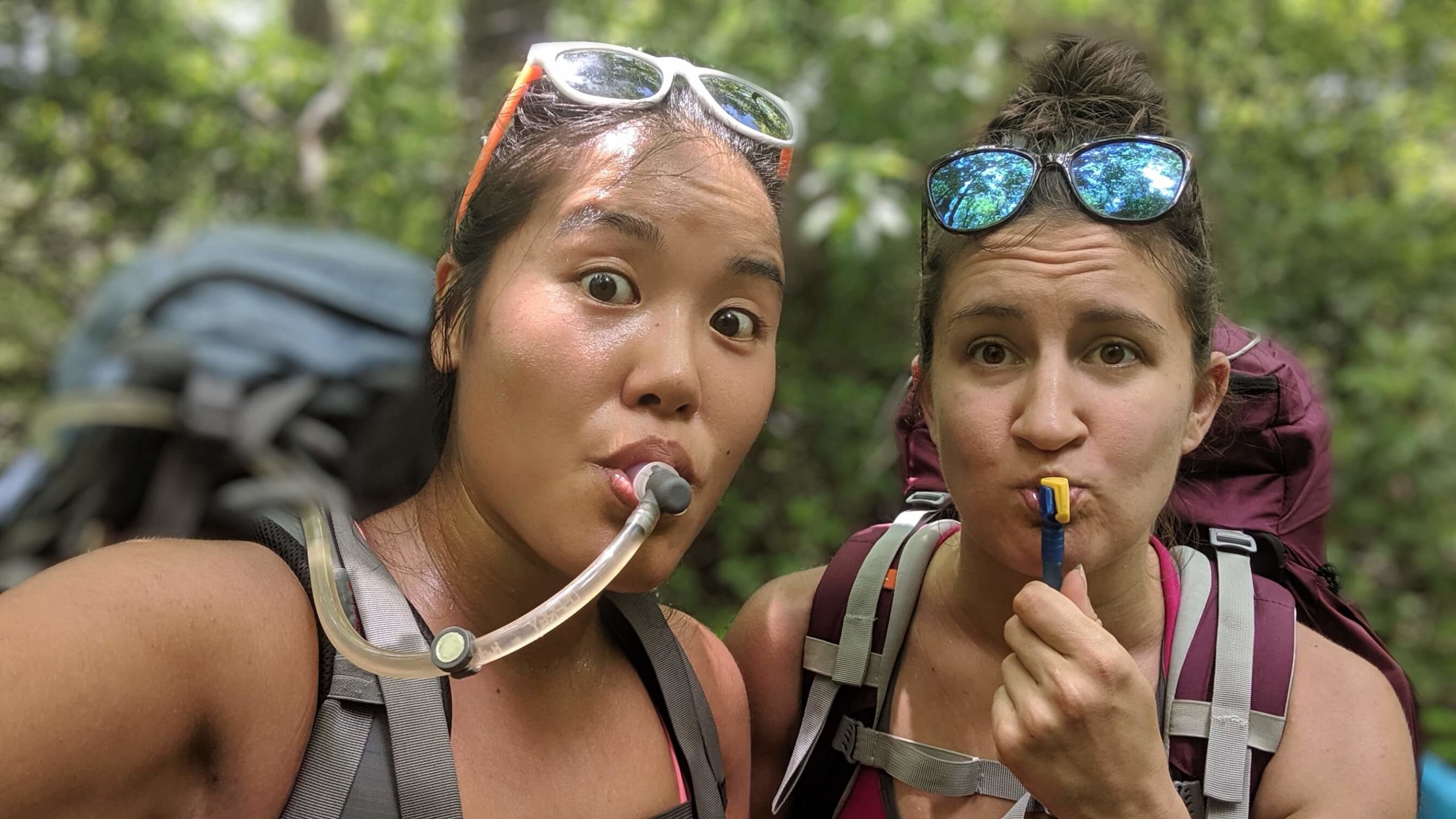
Don’t forget to HYDRATE!
Of these 32 items, the first 15 are the ones I found to be the most important. These items were not only agreed upon by two outdoor experts: NOLS & REI, but also by another blogger who has a hefty amount of outdoor experience. The second half of the list is also highly recommended, but I did not find the items on ALL the lists I researched.
If you’re feeling overwhelmed (I’m feeling a bit overwhelmed writing this post myself! It’s been a while since my Wilderness First Aid Class and I’m a kinesthetic learner!), get started with a simple first aid kit.
Honestly, if you didn’t know what everything on the list was used for before my explanations, you probably shouldn’t be administering first aid anyways, which is why I recommend a class just so you’re relatively informed to take care of minor things because accidents do sometimes happen.
Some other things you may want to add to your kit are, again, condition dependent. It can be good to carry an epi-pen for example if you have any bad allergies. (Or just to have in case someone in your group does!). I am absolutely bat-shit obsessed with my KT-tape. So much so that I may have to make a separate post about it. A lot of people recommend Duct Tape. So I decided to research further… (Back to top).
What Do Other People Add to Their Backpacking First Aid Kits?
When writing this post, I wanted to talk to some other regular hikers and backpackers because, like I said, the first aid kit can be very subjective and sometimes people have a better suggestion than a standard first aid list can give you. I also wanted to know what other people actually carry because I myself am not a great example of carrying all the proper first aid gear at the moment.
I think as an expert in the medical field, you will get much longer lists of recommendations from someone who has seen a lot of injury. I think it’s always better to be prepared, but I also don’t live up to that belief because I am hard-headed and haven’t had that experience.
When writing this post, I have gone on countless hikes in the South East (Georgia, South Carolina, North Carolina, Florida, Tennessee and some Virginia), North east (New York, Vermont), and a few out west (Washington, Utah, and Colorado), including some pretty strenuous hikes with boulder fields, rock scrambles, and ladders.
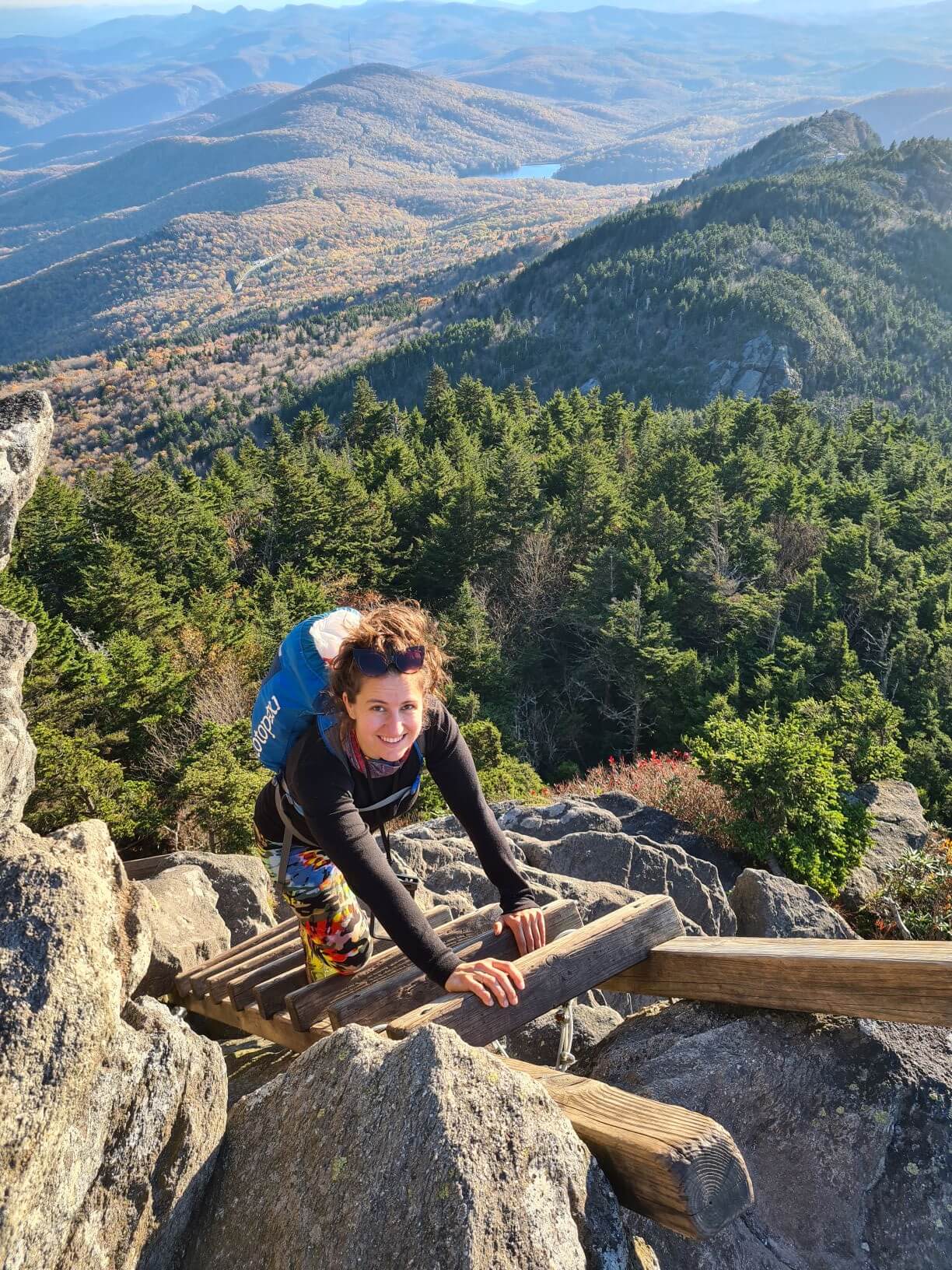
Grandfather Mountain area- one of my #1 places to go hiking!
I’ve been backpacking at least 16 times, including 3 times in a foreign country and one solo trip. I’ve back country and regular car camped and day hiked even more than that and my longest overnight hike was 4 nights. No overnight hikes below freezing temperatures yet. And I currently hike at least once a week.
In that experience, I have learned about my own body’s needs, but also not witnessed a lot of injury (Hallelujah!). My biggest issues I run into are tendonitis, which is why I always carry KT-tape and I’ve had a few cuts and blisters. I’ve run into no one else on the trails with an injury yet, though I have seen a naked guy.
Observing my friends, I’ve seen my friend fall from 10 feet which was pretty terrifying, but she landed in a way that only caused giant bruises (can’t do much about that even with a first aid kit), a twisted ankle and some minor cuts and scrapes. So our first aid kit was enough to handle that. Oddly enough, she climbs trees and rock walls and goes on badass hikes and doesn’t get hurt, but went on our flattest backpacking trip ever to Baker lake and fell because the earth crumbled beneath her at the lake edge.
My other friend I mentioned earlier had the allergic reaction from the bees, which would be preventable (or more manageable) with Benadryl. Ironically, as soon as I added Benadryl to my backpacking first aid kit because of her story, I got my very first bee sting at 31 years old (and caught it on camera haha).
So I’ve been a little stubborn and my personal kit is lacking for sure. I’m going to have to add some more things after writing this post, but the only thing I carry that’s NOT on this list already is the KT-tape I can’t stop mentioning.
I polled my backpacker friends as well as two facebook groups for avid hikers and backpackers to find out what other people suggest. Most items are already covered in the extensive list above, but a few other things to note would be:
- duct tape (I hear it’s versatile)
- glucose tablets
- KT-tape (since it’s not in a list yet)
- blood clotting powder
- cold packs
- epi-pen
- pepto bismol
- nail clippers
- tick key/tornado
Some other things that people mentioned were climbing rope, hot hands hand warmers, ear plugs, water purification tablets, and emergency sleeping bags, but I consider these something that you would want as part of an emergency kit vs. a first aid. I will talk more about what to pack in an emergency kit in an upcoming blog post. (Back to top)
Additional Resources
I tagged a lot of these throughout my blog post, but just in case you missed them, I wanted to create a list below of some great resources to use to read up on first aid and make the best decision for you and your kit:
- REI- Experts in everything outdoor fun, you will not only find endless great information from this company, but also high quality products backed by a phenomenal guarantee
- NOLS- Wilderness First Aid. Must I say anything more? They host really informative first aid classes so you can be up to date on what you need to do in emergency situations
- Two highly recommended medical kit companies: North American Rescue and Adventure Medical Kits
- Some additional bloggers/hikers who are very experienced: Andrew Skurka, Outdoor Gear Lab, & SectionHiker.com
You might also be wondering what else is important to bring with you besides a first aid kit so I wanted to direct you to a few other good posts to get you out on the trails:
That’s it! I really hope you found this post informative and helpful. If you have any questions, comments or suggestions, I urge you to leave a comment below or send me an email via my contact form. Stay safe out there! (Back to top).






Recent Comments